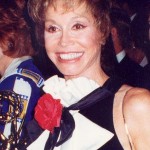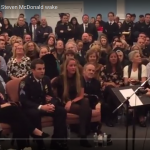The following column was written by The Christophers’ Jerry Costello:
She’s been referred to as a “living legend,” a description that Sister Mary Antona Ebo is quick to deflect. “I guess if I thought I was,” she says without missing a beat, “I’d have to take a step back.”
Not that Sister Mary Antona takes a step back for many people. She’s taken quite a few steps forward, in fact, beginning 48 years ago in Selma, Alabama. That happened in March, 1965, when she marched with Dr. Martin Luther King Jr., responding to his call for a peaceful protest to answer the then-recent Bloody Sunday violence. Now if all the people who claimed to have marched with Dr. King that day were really there, it’s doubtful if the State of Alabama could have held them all.
But Sister Mary Antona really was there. She’s got the memories to prove it.
Anna Weaver told Sister Mary’s story in the Catholic Standard, newspaper of the Washington (D.C.) Archdiocese, last year, when Sister was about to turn 88. And, as the report makes clear, every detail of that historic event stands out in her mind.
Sister Mary Antona, who was from St, Louis, found herself in Selma that day with other members of the Franciscan Sisters of Mary. As the only black nun in the group, she became their de facto spokeswoman when television newsmen and other reporters peppered her with questions–as the cameras rolled.
“All I know was that I was scared to death,” she admits. But still she found the courage to speak, and tried to keep in mind that all people are children of Jesus. “God told me what to say, and it went around the world,” she explained.
It wasn’t long after that–in August of that year, in fact–that the Voting Rights Act was signed into law by President Lyndon Johnson.
She smilingly rejects the notion that her presence in Selma that day had anything to do with that, but this much is clear: her own participation, along with that of thousands of other demonstrators–sure didn’t hurt.
It helped to propel her into a career that involved a passion for social justice; she was one of the founders of the National Black Sisters Conference and served a term as its president. (Nor did she neglect her day job. Trained as a nurse, she went on to become a hospital administrator and chaplain.)
And at every opportunity, she accepted invitations from across the country to speak on the history of the civil rights movement.
“I think that’s why I’ve lived this long, because I’ve got a story to tell you,” she said to the Washington group that had invited her.
“Beware of being silent,” she added. “It’s that silence that gives consent sometimes to the things that we don’t want to give consent to.”
Thinking back to that day that made her a “living legend,” most definitely against her wishes, she says that her brush with fame was short-lived. The next day, Sister Mary Antona said, she and the others were up in time for morning prayer, Mass, and their regular round of duties.
Which, come to think of it, sounds exactly like what living legends are supposed to do.











